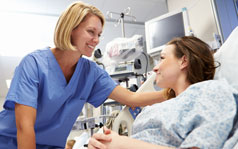Knee Arthroscopy
Contact Us
Request an AppointmentPlease note that a referral letter is required before an appointment can be confirmed.
Please note that a referral letter is required before an appointment can be confirmed.
Useful Information
About this service
An arthroscopy is the examination of the inside of the knee joint with a small telescope or arthroscope. Several small incisions are made into the joint and an arthroscope is then inserted to allow the surgeon to have a look at the joint, which they then view on a TV monitor.
Arthroscopy of the knee is most commonly used for removal or repair of torn cartilage or ligament, or the removal of loose fragments of bone or cartilage. Your Surgeon may recommend an arthroscopy to investigate such symptoms as pain, swelling or instability of the knee joint and may perform arthroscopic surgery to repair the damage.
Although arthroscopic surgery can be used to treat many problems, there may still be some limitations to your activity even after recovery. The outcome of your surgery will often be determined by the degree of injury or damage found in your knee.
For patients who decide to have a knee arthroscopy, the healthcare team will need to make sure that they are healthy and well in advance of the procedure.
The patient's health will be assessed to ensure there are no underlying issues present that could interfere with the procedure. A number of tests may be carried out such as blood tests and electrocardiogram (ECG) as part of this process.
An arthroscopy is carried out under general or spinal anaesthetic and usually performed as day surgery.
The surgeon will make a few small incisions in your knee. A sterile solution will be used to fill the knee joint and rinse away any cloudy fluid. This helps the surgeon to see the knee clearly and in greater detail.
The surgeon's first task is to properly diagnose the problem. They will insert the arthroscope and use the image projected on the screen to guide it. If surgical treatment is needed, the surgeon will insert tiny instruments through another small incision. These instruments might be scissors, motorized shavers, or lasers. This part of the procedure usually lasts from 30 minutes up to over one hour. How long it takes depends upon the findings and the treatment necessary.
As with any surgery, there are risks associated with knee arthroscopy. These occur infrequently and are minor and treatable.
Complications
Potential postoperative problems with knee arthroscopy include:
- Infection
- Blood clots
- Accumulation of blood in the knee
Warning signs
Call the surgeon immediately if you experience any of the following:
- Fever
- Chills
- Persistent warmth or redness around the knee
- Persistent or increased pain
- Significant swelling in the knee
- Increasing pain in the calf muscle
- Once the surgery is complete, the patient will be taken to the recovery room. A nurse will continuously monitor them until fully awake and alert.
- The patient will then be transferred back to the day ward until considered fit for discharge. This usually takes about two to three hours.
- Patient's must have someone to collect them from hospital and stay with them the evening after the surgery in case they become sick or need help.
- Depending on the length and complexity of the surgery, patient's will be instructed about activity level and follow up.
- After most arthroscopic surgeries, patients can walk unassisted but the surgeon may advise crutches for a period of time after surgery. If crutches are required they will be provided and patients will be taught how to use them.
- More weight can gradually be put on the leg as the discomfort subsides and strength is regained in the knee.
- For the first week after the operation it is advisable not to stand for long periods. The leg should be elevated on a small stool or similar, while sitting. This will help reduce the swelling and encourage healing.
- Depending on the condition treated, patients may gradually return to normal activities as advised by the surgeon.
- Exercise the knee regularly for several weeks following surgery to strengthen the muscles of the leg and knee.
- A physiotherapist may help with the exercise programme if the surgeon recommends specific exercises.







.jpg?sfvrsn=6a6f32bf_1)


